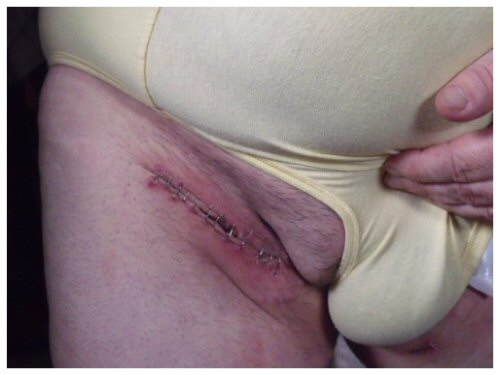Lymphadenectomy…
What is it and what happens afterwards?
LYMPHADENECTOMY continued….
AFTER SURGERY
FOR INGUINAL LYMPHADENECTOMIES
Directly following surgery, the patient will be taken to the recovery room for constant monitoring and to recover from the effects of anesthesia. TED stockings (Anti-Embolism Stockings) will be put on to reduce the build up of lymph that may cause lymphademia. These stockings should be left on except for 20 minutes in the am and 20 minutes at night. A catheter will be in place. The patient may then be transferred to a regular room. Patient will remain in bed for 48 hours. Legs may be elevated some to help prevent post-surgical swelling. Drains placed during surgery to remove excess fluids from the surgical site will remain until the amount of fluid collected in the drain decreases significantly. Staples will be left in for
approximately 10-14 days. The patient will generally remain in the hospital until ambulating well; approximately 5-7 days before going home.
Specific steps should be taken to minimize the risk of
developing lymphedemia, a condition in which excess fluid is not properly drained from body tissues, resulting in swelling. This swelling can sometimes become severe enough to interfere with daily activity. Prior to being discharged, the patient will receive the following instructions for care of areas of the body that may be affected by lymph node removal:
An antibiotic will be given for a period of 7-10 days. Take as directed until all medication is used.
Usually drainage tubes will be pulled before going home. make sure area is cleaned with saline and covered with non-adherent dressings until there is no discharge. Once healed leave open to air. If drainage tubes remain in on discharge, you will be instructed as to how to care for them.
Incisions are to be cleaned with saline and covered with non-adherent dressings until there is no discharge. If any pain, fever, puss or angry redness appears at the site, go to emerge immediately. Infection is a major problem with this surgery and must be watched carefully.
Tight elastic bands should be avoided.
No heavy lifting. No driving for 3-4 weeks approximately. Check with your doctor.
Elevate scrotum to prevent lymph from settling. Wear underwear that has some support
Be vigilant with wearing TED stockings, making sure there is no marks of being too tight on top; if so, cut.
An advantageous move would be to get your doctor to refer you to a physiotherapist who specializes in lymphemia. They will teach you what you can do to help yourself from developing genital edema, as well as massage techniques that aid in transporting the lymph away from the legs and groin area.
| After surgery dressings will be changed and drains will be emptied twice a day. Drains are held in place by a stitch and are a couple of inches below the incision area. |
 |
Staples are usually used; approximately 12 on each side. Numbness can occur in legs due to severed nerves during lymph node dissection. Elevating the legs as well as the scrotum by using a towel helps alleviate lymph from settling in that area. |
 |
|
It is of utmost importance to adhere to all things suggested so to help yourself in the healing process of this major surgery. Everyone |
|
|
|
|
Wearing supportive underwear to “lift” the scrotum as well as have no tight elastic where the lymph pathways are, prevents lymph build up in areas that will cause only more problems. Remaining active helps promote healing and flow of lymph. Once area is healed, remember to wear the anti-embolism stocking higher so to deflect any lymph to collect in the top part of the legs. |
For info on lymphedemia and genital edema see next page
Continued on page 3




